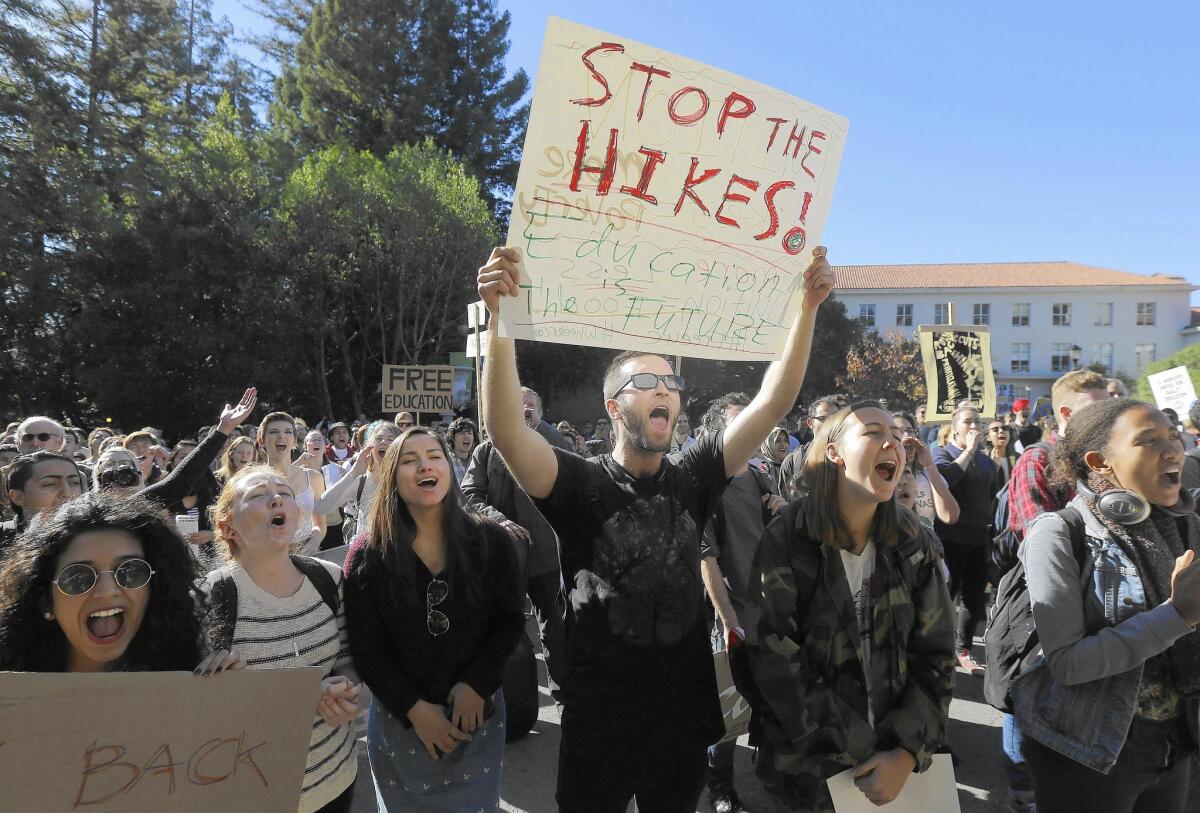Op-Ed: The UC system needs a tuition hike. Here’s how to make it fair

Californians want education to be affordable. They also want great universities. But with costs rising and tuition basically frozen since 2011, something has to give. The University of California system needs a tuition hike.
The fairest way to do this is through “cohort-based tuition,” a proposal the University of California’s Board of Regents will consider at its Jan. 22 meeting.
Under a cohort-based model, tuition is set at the time a student enters a UC degree program and then is kept flat for that cohort for the next six years as long as a student remains enrolled. Any changes in tuition would apply only to new, incoming cohorts.
The proposal would be a huge help to campuses in planning and programming, since they would be able to project tuition revenue from continuing students and thus have a clearer sense of future resources. The approach also provides sorely needed predictability for students and their families, allowing them to know what they will be paying each year.
In the past, that was a huge problem. Between 2000 and 2010, undergraduate in-state tuition rose in nine out of 10 years, with increases ranging from $384 to $1,818 per year. Students and their parents were understandably upset about the unpredictable cost of attending college and the challenge of meeting ever-higher fees.
But the response to the situation — a virtual tuition freeze for the next nine years — is unsustainable.
In California, higher education spending accounted for 18% of the 1976-77 state budget, but by 2019-20, funding had fallen to 12% of the state budget. These cuts have been felt most strongly at the University of California, where state funding per full-time student fell from nearly $29,000 per year to less than $13,000 in inflation-adjusted dollars. In recent years, the state has also required the university to take substantially more students.
Gov. Gavin Newsom’s newly proposed budget for next year includes a welcome 5% increase in state funds for the University of California, but this does not begin to offset the need for a tuition increase. Since state funds are only 42% of the core funds the UC relies on to educate students, an increase of 5% in state support translates into a 2.1% increase in the budget, which barely covers inflation. The budget proposal also mandates that schools serve more students. An increase in tuition is essential simply for the UCs to stay even, without beginning to make up for a decade of cuts and frozen tuition.
Since 2011, annual tuition has been raised only once, by $282 (about 2.5%) in 2017. Meanwhile, in other states, tuition continued to rise during that period. According to the College Board, “in-state tuition and fees at public four-year institutions increased at an average rate of 2.2% per year beyond inflation” between 2009 and 20019. And that figure is what was raised beyond inflation. The UC system faced the same kind of inflation and increased costs during the period, with almost no increase in tuition.
Without substantial additional funds, class sizes will grow, students will find it harder to take the classes they need to graduate, recruiting and retaining top faculty will be much harder and there will have to be cuts in funding for important research. Those assertions aren’t made lightly or with the intent of frightening potential students. They are simply the grim reality.
Of course, students struggling to pay for school are alarmed at the idea of any increase in tuition. But frozen tuition also hurts the students who most need financial assistance from the university. The nontuition costs of attending college — books, health insurance, rent and food — increased by 17.8% from 2012 to 2018, but the university has had no additional funds to help needy students meet those increases because of the freeze. We need to simultaneously increase both tuition and financial aid. The UC system redirects about one-third of undergraduate tuition income — more than $750 million per year — toward financial aid for lower- and middle-income state residents, and that should continue.
It is impossible to overstate the importance of the University of California to the state and its residents, especially in its promotion of social and economic mobility. According to a New York Times study, six of the top seven universities in terms of the economic diversity of their students were UC campuses. The system’s strong public mission makes it different from even the best private schools, but that hasn’t sacrificed quality. The universities’ research in countless fields continues to be invaluable.
Today, the state’s residents — and the UC regents — are at a point where they must decide whether to continue to have a great university system. The path of the last decade, if continued, will undermine quality in a way that cannot be easily restored. The regents should approve cohort-based tuition and implement predictable tuition increases to maintain and enhance the quality of the country’s finest public university system, the University of California.
Erwin Chemerinsky is dean of the UC Berkeley School of Law and a contributing writer to Opinion.
More to Read
A cure for the common opinion
Get thought-provoking perspectives with our weekly newsletter.
You may occasionally receive promotional content from the Los Angeles Times.






